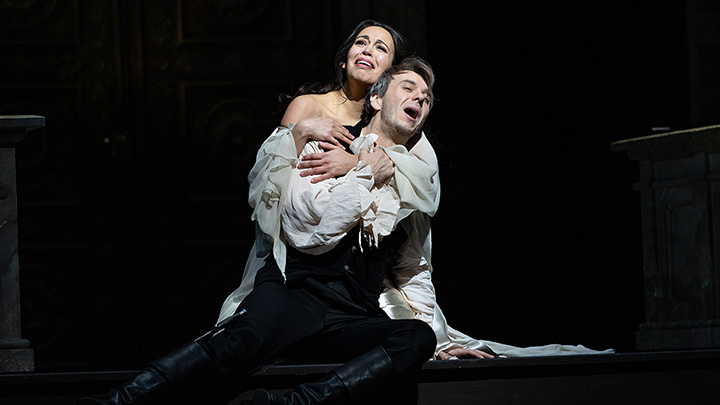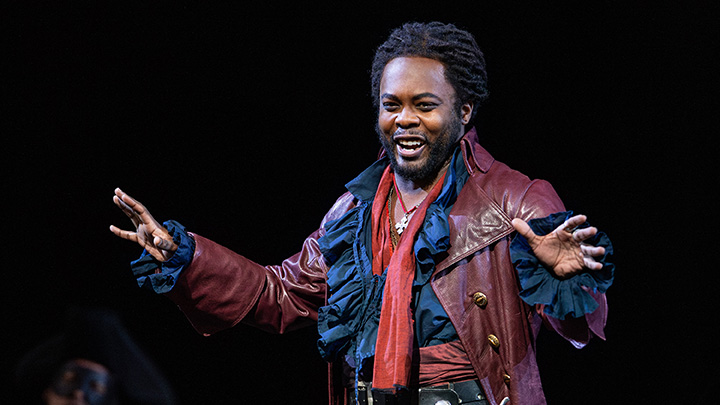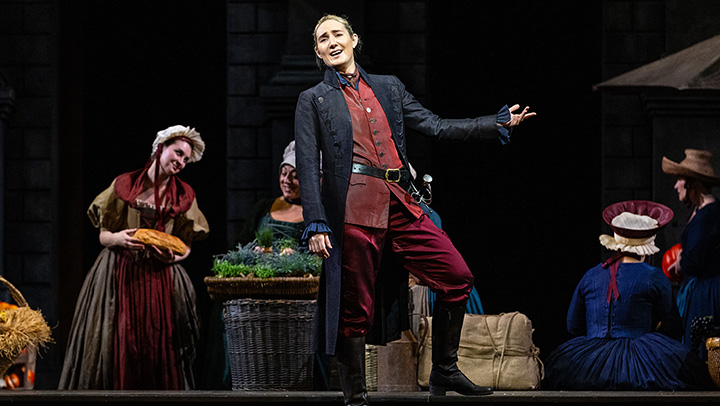
Popular culture has transplanted those two lovers out of Verona and into as many reconfigurations, adaptations and parodies as there are stars to cross in the sky. Indeed, it’s often difficult to untangle the potency of Shakespeare’s text from its legacy of well-trodden tropes and eighth graders stumbling their way through iambic pentameter.
Charles Gounoud’s Roméo et Juliette, which premiered at the Théâtre Lyrique in 1867, is certainly an elegant setting, boasting luscious melodies and three standout arias of the French repertoire. Yet the score’s unrelenting prettiness, combined with a pedestrian libretto by Jules Babier and Michel Carré, forgoes its source material’s violent, lusty edge in favor of dramatic and musical efficiency. The strings swell and the winds sigh exactly when they are supposed to—and the effect is lovely, if generally uninspiring.
Yet, the opening performance of the Metropolitan Opera’s revival of this work, led by music director Yannick Nézet-Séguin, made me rethink my jadedness.
From the outset, Nézet-Séguin emphasized the score’s instances of contrasting moods to enliven its more mannered passages. He led the Metropolitan Opera Orchestra through a roiling account of the overture that plunged the audience into a Verona rife with danger and tragedy. He drew out a palette of dark colors without resorting to some of his more bombastic tendencies. The following ball scene sparkled at an appropriately jaunty clip. He imbued the short musical prelude to Act II with a spaciousness and gracefulness that allowed Hannah Cope’s harp to shimmer into the auditorium. It was some of the most ravishing playing I have heard from the orchestra this season. His conducting throughout the evening was discerning and balanced; each gesture and dynamic shift felt calibrated to extract the greatest dramatic impact, and yet subtle enough to honor Gounod’s more intimate intentions.
It certainly did not hurt that he had one of this season’s strongest revival casts at his disposal, headlined by Nadine Sierra and Benjamin Bernheim as the titular lovers. They too adopted a subtle approach to their roles that was no less impactful. When this production, by Bartlett Sher, opened in 2017, Diana Damrau and Vittorio Grigolo brought full-throttle intensity and histrionics to their roles. Their interpretations affirmed your typical snotty eighth grader’s assessment of story: “they were never in love and they just wanted to get laid—it was all hormones.” By contrast, the sincerity of Sierra and Bernheim’s performances challenged that assessment and my apathy towards the material.
Bernheim played Roméo as a wistful sort, seemingly ill at ease among his cavorting Montague brethren and in his rakish leather frock and Fabio-style open shirt. Upon beholding Juliette, that wistfulness transformed into genuine enchantment, and he infused a sweet shyness into the opening phrases of “Ange adorable,” the first of the piece’s four love duets. Bernheim possesses many of the qualities of an ideal French tenor: a bright timbre, a slightly nasal resonance, and an easy upper register that floats into the quieter moments of the score. There was an aching, unforced tenderness to his “Ah! lève-toi, soleil!” that bloomed into complete rapture by the aria’s end. I was swooning.
If Bernheim is an ideal French tenor, then Sierra is an equally ideal lyric soprano for the demands of the Metropolitan Opera’s cavernous auditorium. Her upper range is suitably light and dexterous for this repertoire, and her middle range has a full, creamy tone and considerable power. After a very charming and coy display of her technical prowess in “Je veux vivre,” she spun delicate phrases throughout the balcony scene and conveyed an unstudied sweetness in her declarations of love to her Roméo. The Poison Aria was a highlight of the evening, as Sierra navigated Juliette’s shifts between terror and resolve with full dramatic commitment and a gorgeous trill at its climax.
Together, the two made for an appealing pair with ample chemistry. Their voices melded seamlessly in each of their duets, and especially in “Nuit d’hyménée,” which they infused with a melting sensuality. Such lovely singing fully justified the final act’s musical and dramatic indulgences. (Though I admit that Juliette waking while Roméo is still alive is necessary in an operatic context.)
Two equally charismatic singers represented the violent aspects of the Capulet-Montague feud: baritone Will Liverman as Mercutio and tenor Frederick Ballentine as Tybalt. Though Barbier and Carré’s libretto skims over much of the social and political implications of the feud, Liverman and Ballentine evoked its all-consuming intensity their muscular, fiery performances. Liverman’s suave delivery of Act I’s “Mab, la reine des mensonges” was jocular, though there were some slight coordination issues with the pit. Samantha Hankey cut an unusually debonair figure as the page Stéphano as she swaggered her way through a richly sung “Que fais-tu, blanche tourterelle.”
As Frère Laurent, bass-baritone Alfred Walker brought warmth and an expressive handling of the text. Though the friar’s music is not particularly distinctive in either of his scenes, Walker’s animated delivery ensured that he remained an engaging presence. Mezzo-soprano Eve Gigliotti was a convivial Gertrude and managed to sidestep the hoarier aspects of the role. Nathan Berg’s Capulet sounded a tad dry, though he was affecting in his grief for Tybalt. Daniel Rich amused as the foppish Pâris, and Jeongcheol Cha and Richard Bernstein impressed with their rich, rounded bass-baritones in their respective roles of Grégorio and the Duke.
Sher’s production, directed in revival by Gina Lapinski, sets the entirety of the action in a piazza outside the grey, sepulchral walls of the Capulet’s palazzo, emphasizing the lovers’ inability to escape the shadows of their families and the violence in the streets even in their most intimate moments. Lavish 18th century costumes by Catherine Zuber as well as some surrealistic touches—the chorus’s dead-eyed stare towards the audience during the prologue, a slowly descending column, eerie commedia dell’arte masks, and Juliette’s somnambulistic descent into the tomb—recall Fellini’s uncanny rendering of Enlightenment Europe, but to what end? Still, the onstage action is dynamic and engaging, and Act III’s sword fights remain exciting. There were several small, character-building moments to relish, such as Juliette’s attempts to dissuade Pâris’s attention during the ball and Roméo boyishly crossing himself as he bounded into the friar’s chapel.
It was an evening to remind us that a committed cast at the top of their game can elevate a revival into must-see theatre—and that this level of quality is exactly what the Met’s audience deserves on a regular basis.
Photos: Marty Sohl/MetOpera




























Comments